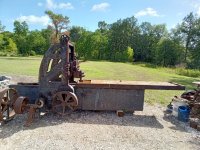M.B. Naegle
Titanium
- Joined
- Feb 7, 2011
- Location
- Conroe, TX USA
Just to elaborate on my earlier musings on this plainers age, the Feb. 15, 1898 patent that is tagged on the machine is for the 2nd belt drive, and the patent images look closer to this plainer than the later more improved design.This plainer looks very close to those in my 1920's Whitcomb Blaisdell/Becker catalog (need to get it scanned and uploaded to vintage machinery...), but does lack a few advancements such as a two speed counter-shaft, and outboard support of the pulleys. By the 1920's, they no longer had the makers info cast into the base casting and only had it on the top rail. Whitcomb and Blaisdell got together in 1905. Not sure if they immediately updated the pattern lettering though, but by the 1920's when they merged with Reed-Prentice and Becker, the plainers bore both Whitcomb and Blaisdell names. So, given the patent date and lack of Blaisdell name on this one, and that it's got the solid base casting design, I'd put it between 1898 and 1905, likely no later than 1910.
......
2nd Belt Patent
While we're on the subject too, the cross bar binding design was patented Sept. 1, 1868.
Cross Bar Patent
And the feed indexing mechanism was patented Aug. 17, 1869
Feed Indexing Patent
And in Feb. 17, 1903 they patented a belt driven power feed, different than what's on here, so I assume this plainer predates that.
Power Feed
So all that closes up the age range a little. 1898 to 1903. I'm leaning on the earlier side of that with this 2nd belt design. The patent tag mounted by the mechanism may have been since it was still new and a selling point.


 ). Being exposed to the elements at least means that there's not much by way of grime and paint to remove. Just lots of "surface" rust.
). Being exposed to the elements at least means that there's not much by way of grime and paint to remove. Just lots of "surface" rust.
 ). I plan to make the thickness a little undersized and shim the rack to the correct height. Before I put the table on, I also want to flip it over and get a matrix drawn up of all the mounting holes.
). I plan to make the thickness a little undersized and shim the rack to the correct height. Before I put the table on, I also want to flip it over and get a matrix drawn up of all the mounting holes.






